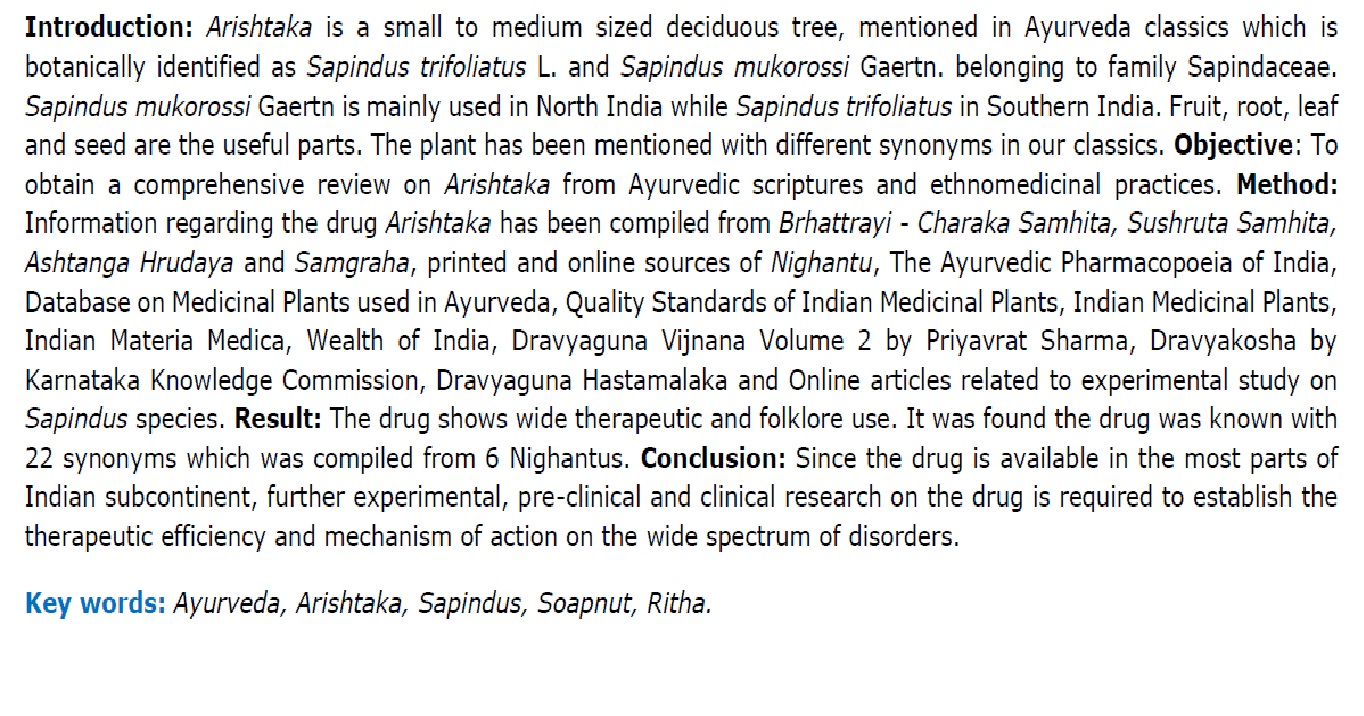Comprehensive review on Arishtaka (Sapindus trifoliatus L. and S. mukorossi Gaertn)
Keywords:
Ayurveda, Arishtaka, Sapindus trifoliatus, Soapnut, RithaAbstract
Introduction: Arishtaka is a small to medium sized deciduous tree, mentioned in Ayurveda classics which is botanically identified as Sapindus trifoliatus L. and Sapindus mukorossi Gaertn. belonging to family Sapindaceae. Sapindus mukorossi Gaertn is mainly used in North India while Sapindus trifoliatus in Southern India. Fruit, root, leaf and seed are the useful parts. The plant has been mentioned with different synonyms in our classics. Objective: To obtain a comprehensive review on Arishtaka from Ayurvedic scriptures and ethnomedicinal practices. Method: Information regarding the drug Arishtaka has been compiled from Brhattrayi - Charaka Samhita, Sushruta Samhita, Ashtanga Hrudaya and Samgraha, printed and online sources of Nighantu, The Ayurvedic Pharmacopoeia of India, Database on Medicinal Plants used in Ayurveda, Quality Standards of Indian Medicinal Plants, Indian Medicinal Plants, Indian Materia Medica, Wealth of India, Dravyaguna Vijnana Volume 2 by Priyavrat Sharma, Dravyakosha by Karnataka Knowledge Commission, Dravyaguna Hastamalaka and Online articles related to experimental study on Sapindus species. Result: The drug shows wide therapeutic and folklore use. It was found the drug was known with 22 synonyms which was compiled from 6 Nighantus. Conclusion: Since the drug is available in the most parts of Indian subcontinent, further experimental, pre-clinical and clinical research on the drug is required to establish the therapeutic efficiency and mechanism of action on the above-mentioned disorders.
Downloads
References
Upadhyay A, Singh DK. Pharmacological effects of Sapindus mukorossi. Rev Inst Med Trop Sao Paulo. 2012 Sep-Oct;54(5):273-80. doi: 10.1590/s0036-46652012000500007. PMID: 22983291.
Chunekar K.C., Bhavaprakasha Nighantu of Bhava Mishra; Chapter Vatadi Varga: Verse no. 38; Varanasi: Chaukhambha Bharti Academy, 2015, p.517
Sharma P.V., Sharma G, Kaiyadeva Nighantu, Chapter Aushadhi Varga, Verse No. 981; 2019, Varanasi: Chaukhambha Orientalia, p.181
Sastry J.L.N., Illustrated Madanapala Nighantu, 1st ed, Chapter Vatadi Varga, Verse No. 67; 2010, Varanasi: Chaukhambha Orientalia, p.552
Sankhyadhar S.C., Chunekar K.C., Raja Nighantu,1st ed., Chapter Prabhadradi Varga; verse no.71-72,2012, Varanasi: Chaukhambha Orientalia, p.433-38
Sharma P.V., Shodhala Nighantu of Vaidyacharya Shodhala, 1st ed., Chapter Lakshmanadi Varga; Verse no. 577; 1978, Baroda: Oriental Institute, p.141
Sharma P.V., Priya Nighantu, Chapter Haritakyadi Varga, Verse no.250; 2004, Varanasi: Chowkhambha Vidyabhwan, p.54
CCRAS, Database on Medicinal Plans used in Ayurveda, Vol. 6 New Delhi, p.20
Kirtikar K.R. and Basu B.D., Indian Medicinal Plants Vol. 1, 2nd ed., Dehradun, International Book Distributors, p.631-32
Dwivedi Vishvanath, Dravyaguna Hastamalaka, Jaipur, Publication Scheme, 1986, p.427
Karnataka Knowledge Commission, Dept. of AYUSH, GAMC, Bengaluru, Dravyakosha Vol. 1, 1st ed., p.32
Sharma P.V., Dravyaguna Vijnana Volume 2, Chapter 5, 2018, Varanasi: Chaukhambha Bharati Academy, p.385
Nadkarni KM., Indian Materia Medica Vol. 1, p.1162
B. Arul, R. Kothai, Philip Jacob B. Sangameswaran & K. Sureshkumar (2004) Anti-Inflammatory Activity of Sapindus trifoliatus Linn., Journal of Herbal Pharmacotherapy, 4:4, 43-50, DOI: 10.1080/J157v04n04_04
Arulmozhi DK., et al., Effect of ect of Sapindus trifoliatus on hyperalgesic in vivo migraine models. Brazilian Journal of Medical and Biological Research (2005) 38: 469-475
Rahman S.S., et al., Investigation of Sapindus Mukorossi Extracts for Repellency, Insecticidal Activity and Plant Growth Regulatory Effect. Journal of Applied Sciences Research, 2007 3(2): 95-101
Mali R.G., Mehta A., A Review on Anthelmintic Plants. Natural Product Radiance, Vol. 7(5), 2008, pp.446-475
Tiwari P., et al., Anti-Trichomonas activity of Sapindus saponins, a candidate for development as microbicidal contraceptive. Journal of Antimicrobial Chemotherapy (2008) 62, 526–534, doi:10.1093/jac/dkn223
X.-W. Zhu et al., In vitro and in vivo antitumor effects of the extract of Sapindus spp., Journal of the Taiwan Institute of Chemical Engineers (2016), http://dx.doi.org/10.1016/j.jtice.2016.06.010
Pradhan D., Pharmacological effect of some fractions obtained from Sapindus trifoliatus acting as an antioxidant and against mammary cell proliferation., African Journal of Pharmacy and Pharmacology,
-May-8, Vol.8(17), pp455-463. DOI: 10.5897/AJPP2014.4028
Kishore DV., et al., Anti-Ulcer activity of Methanolic and Aqueous extract of leaves of Sapindus trifoliatus Linn., International Journal of Pharmaceutical Sciences Review and Research, 2011-Jan-February, Volume 6, Issue 1
Acharya JT, Sushruta Samhita of Sushruta with Nibandhasangraha tika of Sri Dalhanacharya, Uttaratantra, Chapter 39: Jwara Pratishedha, Verse No. 284, 2013, Varanasi: Chaukhambha Sanskrit Sansthan, p.692
Acharya JT, Sushruta Samhita of Sushruta with Nibandhasangraha tika of Sri Dalhanacharya, Uttaratantra, Chapter 39: Jwara Pratishedha, Verse No. 285, 2013, Varanasi: Chaukhambha Sanskrit Sansthan, p.692
Joshi K., Nishteswar K. A Review of ethnoveterinary practices associated with animal healthcare in barda hills Gujarat, India. Pharma Science Monitor 5(1). 2014 Jan-Mar.
Gupta KA., Ashtanga Hrdayam of Vagbhatta edited with Vidyotini Hindi commentary, Chikitsasthana, Chapter 1: Jwara chikitsa, Verse No. 134-135, 2019, Varanasi: Chaukhambha Prakashan, p.403
Gupta KA., Vagbhatta’s Ashtanga Samgraha with Hindi commentary Volume 2, Chikitsasthana, Chapter 2: Jeernajwara chikitsa, Verse No. 75, Varanasi: Chowkhambha Krishnadas Academy, p.12
Gupta KA., Vagbhatta’s Ashtanga Samgraha with Hindi commentary Volume 2, Uttaratantra, Chapter 44: Lutavisha pratishedha, Verse No. 34, Varanasi: Chowkhambha Krishnadas Academy, p.370
CSIR, Wealth of India Volume 9, New Delhi, p.225
ICMR, Quality Standards of Indian Medicinal Plants Vol. 3. New Delhi, 2005, p.326-327
Acharya JT, Charaka Samhita by Agnivesha, Chikitsasthana, Chapter 29: Vatarakta chikitsa, Verse No. 110, 2016, New Delhi: Chaukhambha Publications, p.632















